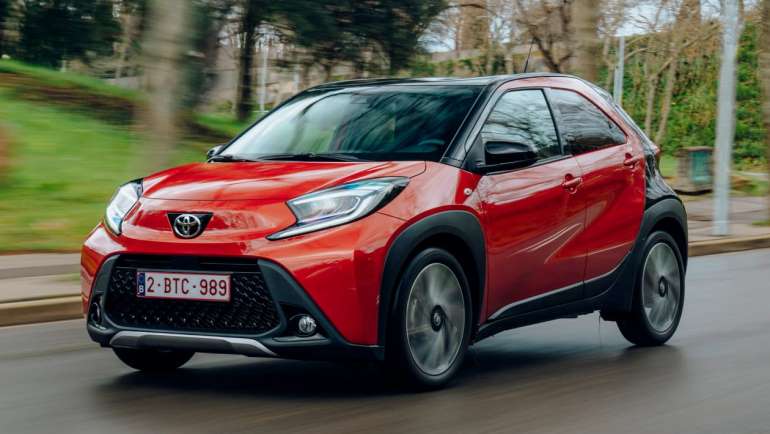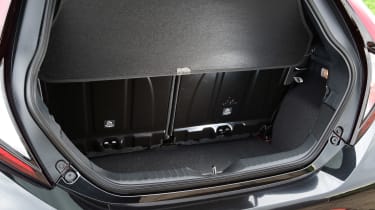Pros
- Affordable
- Smooth ride
- Well equipped
Cons
- No electrification
- Cramped rear seats
- Sluggish acceleration
The Toyota Aygo X (pronounced Cross) is the Japanese giant’s bet on the future of the city car; a small, nippy hatchback with the styling of an SUV and raised suspension. It looks ideally suited to Britain’s often less than ideal roads, which are strewn with potholes and speed bumps.
It’s still instantly recognisable as an Aygo, but now with even more expressive headlights, tough, fashionable body plastic cladding and large 17- or 18-inch alloy wheels pushed as far to each corner of the bodywork as they’ll go. But with the upgrades comes a price hike, and it remains to be seen if first car buyers and city car shoppers on a budget will stump up the extra cash.
This is a bold, contemporary look, but Toyota has been rather more conservative in other areas. While there are bright coloured pieces of trim around the infotainment touchscreen and gearlever, you’ll also find an analogue instrument cluster and plenty of hard, durable plastics. In other words, it’s a reminder that the Aygo X starts from around £15,000 – a price point where manufacturers struggle to make a profit nowadays.
Under the short bonnet of the Aygo X’ there’s an evolution of Toyota’s tried-and-tested 1.0-litre three-cylinder petrol engine – with no hybrid or all-electric version on the horizon. It’s a traditional take on the city car formula, that keeps the cost of buying or leasing the Aygo X very low, and will prove cheap to run for private buyers. However, its tailpipe emissions of just above 100g/km won’t make it as appealing for business users as an EV like the electric Fiat 500, Honda e or MINI Electric. Official fuel-efficiency figures are between 57.6 and 60.1mpg.
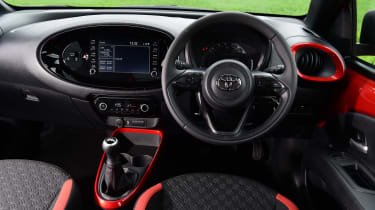
On the road, the Aygo X has light steering and its slightly raised view out feels like an advantage on congested city streets. The raised suspension feels like a net gain too, because while it has slightly more lean in tight corners, it’s better at soaking up bumps. Its engine feels rather old fashioned, though, with a fairly loud thrum under acceleration that’s characterful, but not especially relaxing with either the five-speed manual or CVT automatic gearbox.
The Toyota Aygo X is a comfortable and fun city car that feels much more contemporary inside, thanks to the latest technology. However, the extra price it commands following its SUV makeover might price it out of the first-car market, and it’s a shame it misses out on Toyota’s excellent hybrid technology.
Unlike many rival manufacturers which are launching electric superminis like the Fiat 500, Toyota is sticking with a small petrol engine for the Aygo X. While this doesn’t have the stark running cost advantages, it does ensure the small Toyota is relatively affordable to lease or buy.
Toyota Aygo X MPG & CO2
There is no choice of powertrains in the Aygo X – your only decision is whether to specify the 1.0-litre three-cylinder engine with a five-speed manual or a CVT automatic gearbox – the former returns up to 60.1mpg and emits 107g/km of CO2, while the auto gets 57.6mpg and 110g/km. During our test drive we saw just 40.1mpg on the trip computer. For this reason, we’d say the manual is a better bet unless you really need the ease of an automatic in urban traffic.
Emissions of just over 100g/km mean the Aygo X sits in a middling Benefit-in-Kind band for company-car drivers.
Insurance groups
The Aygo X wins back points for being cheap to insure; entry-level manuals sit in the frugal insurance group 5, while even fully loaded automatic cars only reach group 7. Its VED (road tax) bill will also be the standard amount for combustion-engined models, keeping additional costs to a minimum.
Warranty
Following the standard three-year/60,000 mile warranty, the Aygo X also qualifies for Toyota’s ‘Relax’ warranty, which can cover the car for up to 10 years/100,000 miles, and is activated each time the car is serviced at a Toyota dealership; if you’re happy to stick to these terms, it’s even longer than the seven-year warranty offered with the Kia Picanto.
Servicing
For £15 a month Toyota will provide the first three services and roadside assistance for three years.
The Toyota’s quasi-SUV looks aren’t just for style, they also affect the driving experience. Nipping through city traffic, the raised driving position means you feel like the view out is slightly better than in rivals (the driver’s seat is 55mm is higher than before), and light, quick steering makes it easy to confidently drive through narrow gaps and make lane changes.
There’s a small amount of body lean to remind you of the taller ride height, but the Aygo X handles in a neat and reassuring fashion, so you can tackle a winding road without the car feeling out of its element. It’s clear the new underpinnings from the Toyota Yaris have made the Aygo X feel more mature to drive all-round than the outgoing car, which sometimes felt a little insecure at higher speeds.
Toyota Aygo X petrol engine
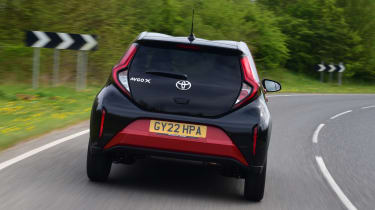
Those hoping for a smaller, funkier version of the Toyota Yaris Cross SUV will be disappointed, because the Aygo X forgoes that car’s frugal hybrid powertrain. Instead, the Aygo is only available with a somewhat outdated-feeling 1.0-litre three-cylinder engine which lacks any kind of hybrid assistance.
This produces 71bhp and while that may seem pretty slow, it is well suited to nipping around busy city streets. Under acceleration, the thrum of the engine can be obtrusive; this is something you’ll hear often as getting up to speed takes a lot of effort. The sprint from rest to 62mph takes a leisurely 14.9 seconds – nearly six seconds slower than the electric Fiat 500.
In the Toyota, buyers have the choice of two transmissions: a five-speed manual or a CVT automatic gearbox. The former is slick enough, with the lack of a sixth gear a clear indicator that this car is not really intended for motorway driving. The CVT ’box adds somewhat to refinement, but it’s not the best of its ilk, which makes getting up to speed even more of a chore.
Most city cars are fitted with small wheels and cost-saving suspension, so they can struggle with potholes and speed bumps, but the Aygo X does well here. Its new underpinnings and raised ride mean it soaks up rough surfaces as well as a car from the class above, making it ideal for Britain’s pockmarked streets. There’s a bit of wind and tyre noise at higher speeds, but on the whole, the Aygo X feels solid.
Toyota Aygo X dashboard
Toyota has designed the Aygo to be cheerful, with lots of oval shapes and some colourful trim for the air vents and touchscreen surround to keep it youthful. But it’s also clear this is a car built to have an affordable price tag, with reminders like the hard plastics and exposed metal on the door panels and some of the dashboard. Happily, Toyota does a good job of making these materials feel like they’ve been chosen to be durable, not just to save pennies. We also think the physical climate control dials are far easier to use while on the move than a touchscreen solution.
The touchscreen itself starts off as a seven-inch display and rises to a nine-inch unit in top-spec models. All versions get Apple CarPlay and Android Auto functionality, which is good because Toyota’s system can be a touch laggy at times. Unfortunately, there is no fully digital instrument cluster behind the steering wheel; the Aygo X instead gets a four-inch colour display that can show a small handful of read-outs such as the time, the car’s fuel economy and the current speed.
Equipment
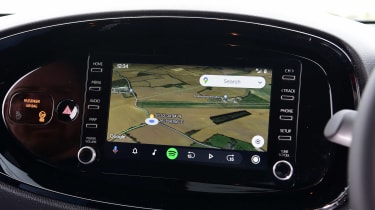
Buyers have the choice of four trim levels when configuring their Aygo X: Pure, Edge, Exclusive and Limited Edition. Starting from around £15,000, Pure is the entry-point into the range, yet still provides a decent level of standard equipment. This includes 17-inch alloy wheels, adaptive cruise control, forward collision warning, lane-keep assist, air conditioning, a reversing camera and the seven-inch touchscreen with Apple Carplay and Android Auto.
Edge trim adds two-tone paintwork, larger, 18-inch diamond-cut alloys, an eight-inch touchscreen and automatic climate control. Stepping up to the Exclusive model, there’s a nine-inch central touchscreen, LED headlights, keyless entry and start, front and rear parking sensors, wireless phone charging and a collision avoidance system. Finally the Limited Edition model gets an exclusive green and orange paint job with gloss black wheels, as well as a JBL sound system, privacy glass, heated front seats and an electrically retractable canvas roof – which turns the Aygo X into the cheapest convertible on sale.
Options
There are few options available for the Aygo X, with most equipment coming as part of different trim levels. Lower-spec cars can be fitted with front and rear parking sensors for around £300, while the novel canvas roof will set you back roughly £900. Aygo X Exclusive cars can be fitted with the JBL sound system for £500, while the only remaining optional extra is the CVT automatic gearbox, which costs just over £1,000 more than the manual.

